New Fin Templates
Wavegrinder Rethinks Fin Design
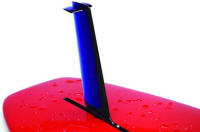 Doug Simpson, founder of the Wavegrinder surfboard fin design, wants you to surf faster. Interested? Thought so. Simpson first put theories of fluid dynamics to use in sports when he started working on America’s Cup racing yachts. He wanted to decrease drag while making the most effective fin possible. Now he brings this knowledge of speed, drag, and hydrodynamics to the surf world. We hope you’re ready.
Doug Simpson, founder of the Wavegrinder surfboard fin design, wants you to surf faster. Interested? Thought so. Simpson first put theories of fluid dynamics to use in sports when he started working on America’s Cup racing yachts. He wanted to decrease drag while making the most effective fin possible. Now he brings this knowledge of speed, drag, and hydrodynamics to the surf world. We hope you’re ready.
SurfScience: What is your background and the story behind your fin design?
Doug Simpson: “I have always been interested in science. I took a lot of science in both HS and college. I took a lot of physics just for fun, but actually qualified to teach physics in high school in California. I haven’t done that.
“I got to thinking about how I might use what I learned in sailing in surfing, particularly when it comes to underwater appendages. In boats we use keels and rudders, but the science is fluid dynamics and it’s the same thing. I wondered why we didn’t do things the same in surfing.
“In sailboats we’ve had winged keels or end plates for years. In Aerospace with wings there have been end plates or winglets for years. Also on Nascar splitters. Fluid is the same, whether it’s air or water. It struck me that we had not employed them in any sort of way in surfing.”
SS: What is the general principle behind your fins?

DS: “Our overriding principle is reductionism. So long as you have enough control, we think that less area is more. In other words, less is faster because it’s less drag. It’s kind of like using a wrench: the longer wrench you have, the less power you need. In a surfboard fin, if you can maximize its power to the side, what we call lift but what most times in surfing is called hold, for each square inch of surface area, if you can maximize that power, you can minimize that surface. The way we do that is by adding winglets, which in effect fool the fluid into thinking it’s bigger than it is.
“What we have done is created a relatively small fin compared to others out there. Every inch is drag, so we concentrated on what we could do to make the surface area smaller.
SS: And fin placement?
DS: “One of the things people talk about is where do I put my fin. One of the principles people seem to miss is one from sailing. If you take a rudder and move it further back then you’re increasing the size of your wrench or lever arm. We’re trying to create the maximum distance between Center of Flotation, which is somewhere under your body, and the center of lateral distance. Moving the fin back creates a larger lever arm; you can crank your turns.”
SS: Aside from the winglet on the fins, what are some important design differences?
DS: “These are symmetrical, foil shaped fins. I did this purposely. I would bet that if you look at thrusters, they started symmetrical without toe-in and over time somebody decided to add some toe-in. That makes as much sense as a snowplow while you’re trying to go fast on snow skis or toeing-in the front tires of your care because sometimes you go left and sometimes you go right. They’re fighting each other if they toed-in. If one side is flat they’re not hydrodynamically optimized. I suggest we have a system that is non toed-in fins that are symmetrical. I would bet that other fin companies will start going that way.”
SS: How does your design affect surfing performance?
DS: “One of the things you can do with a faster system, you get more out of your board. People talk about it as being more lively, making their board more lively. Again, back to the overriding principle. There is not necessarily one size fits all. Fins are a system that work with surfboard rocker, rails, size of surfer, and conditions. If you take identical boards with identical rocker, with identical rails, with identical body weight, some surfers just prefer more hold or turning ability while others will sacrifice that and have it faster and looser.”
SS: What is the biggest disadvantage to your design?
DS: “The biggest disadvantage to the fin design is it looks different. Surfers tend to be free spirited of mind, in general, but completely against something that is new and different, like alternative surfboard fins. It’s hard to convince folks that idea from someone from NASA who studied hydrodynamic principles and America’s Cup racing principles, ideas that BMW spent millions of dollars on, will work. They think someone who made by hand something in their garage 40 years ago is better.”
SS: This is your first stab into the surf consumer market. What has the process been like?
DS: “It’s been a lot of fun because I just did this for myself and one thing led to another. Next thing you know I let people try it and they’re thinking you gotta do something with it. But I’ve just done it for myself really, for fun. I’m just happy to have people enjoy it and know that it works.
“I tell people to try it against their favorite fin. I’ll stack up against anybody’s favorite fin on any board.”
SS: You already have a longboard fin. When can we see a shortboard fin?
DS: “We just came out with a shortboard fin or a thruster fin that fits FCS. FCS has been real good about letting us use their system. If you have a FCS system, then this will work. We have the thrusters and they’re ready to go.
Find more information at wavegrinder.com.

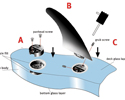
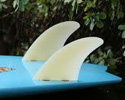
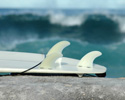


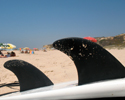
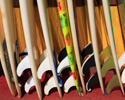
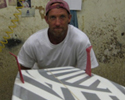
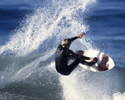

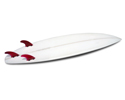
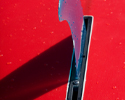
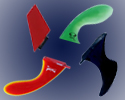
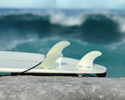
1 Comment